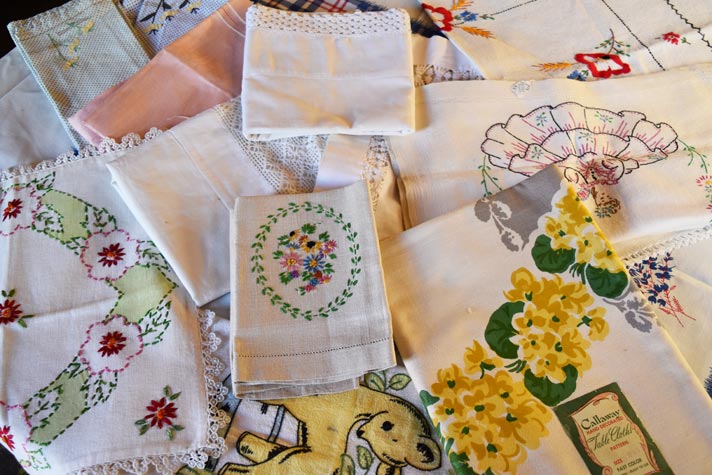Speaking of Antiquing – July 2018
Linen is a textile made from the fibers of the flax plant. The word linen derives from the Latin “linum.” Linens have become the title we give generically to our domestic “textiles.”
That all-encompassing word, regardless of the fabric from which they were made, can include a wide selection of vintage tablecloths, table napkins, placemats, dresser scarves, pillow cases, hand towels, or crochet doilies. Be they cotton, or linen, good quality linens will most likely be adorned with colorful needlework such as cross stitch, embroidery, handmade lace, crochet work, or applied applique.
Girls at a young age were taught to do needlework. It was required in some cultures that before a woman married, that she accumulate several table covers, bed coverlets, napkins, dish towels, and the like.
Techniques from the Danish called “pulled thread embroidery,” created designs on the fabric of the linen napkin or tablecloth. By drawing threads out of the warp of the fabric, open space was created, making an attractive edge. Sometimes left open or bound to make a geometric design, this took skill and time. These are what make table linen hunting fun. Unbroken threads and intricate designs are the prize. These techniques were also used by the Irish, making Irish linen very desirable.
Lovely still is the addition of a crochet lace edge on a tablecloth. Combining drawn thread and crochet is an art form. It has been a tradition for many generations to adorn one’s home with beautiful fabrics and lace. It adds a soothing quality to the furnishings.
Crochet and lace doilies are also an underrated art form. Tatting and crochet work was done almost constantly by women who didn’t have still hands. If you look at the detail in the stitch, and the quality of the thread and intricacy of the patterns, you wonder why we aren’t charging a whole lot more. Many women made collars for their dresses using tatted lace, or bobbin lace, as adornment.
Post WWII, mid-century modern table linens were made from 100% cotton. They were hand hemmed until the late 1950’s. These tablecloths are sought after for their thick fabric, floral or geometric patterns, and matching napkins. They were made in small sizes to cover a card table, a game table, or dining table.
Whatever your preference in linens, at Pickety Place, we have an ample supply to choose from. You will find hand-hemmed, embroidered dresser scarves that will make you wonder how many needle hours were put into it.
We have lovely linen guest towels that are making a comeback in must-have decor. Embroidered pillow cases edged with crochet lace are always a pleasure to use.
You will find crochet bed coverlets that appear to have never been used, and ones that have retained their beauty and desirability. Come and rummage through the bins and cubbies; you will surely find a treasure.

 Margaret Barns is co-owner of Pickety Place Antiques & Collectibles located at 130 N. 4th Street in Jacksonville. LIKE them on
Margaret Barns is co-owner of Pickety Place Antiques & Collectibles located at 130 N. 4th Street in Jacksonville. LIKE them on